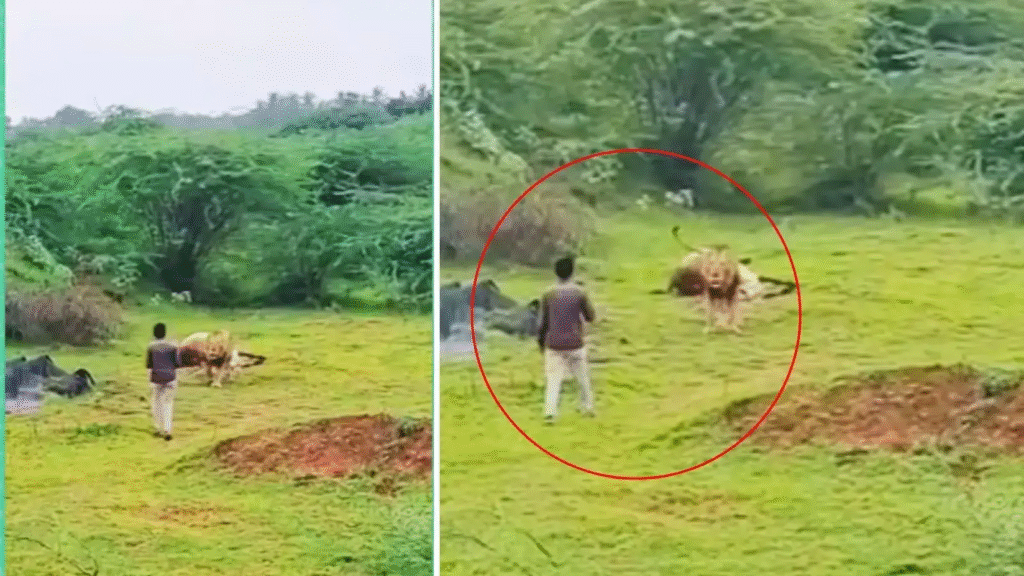Face to Face with the King: Gujarat Man’s Dangerous Encounter with a Feeding Lion Sparks Outrage
Introduction
In a world increasingly driven by digital validation, one man’s dangerous stunt in Gujarat has sparked a national debate. A video surfaced showing a man walking disturbingly close to a wild lion while it was feeding all to capture a dramatic moment on camera. What followed was a mixture of shock, anger, and disbelief, not only at the reckless behavior but at the cultural shift that seems to prioritize “likes” over life.
This single act performed for a few seconds of viral fame has become a symbol of a growing crisis: human intrusion into wildlife spaces, and a troubling disconnect from nature’s dangers. But the story doesn’t stop with the video. It touches on deep-rooted issues of conservation, public awareness, law enforcement, and the psychology behind risk-taking in the digital age.
The Incident: A Dangerous Stunt Unfolds
The event occurred in a rural region near the Gir forest in Gujarat, home to the world’s last surviving population of Asiatic lions. The man, later identified by local authorities, spotted a lion feasting on a fresh kill in a forested patch bordering the village. With a phone in hand, he casually approached the beast slowly, confidently, and without hesitation determined to record a close-up video.
The lion, visibly disturbed by the presence of a human just meters away, paused its meal. Its expression shifted from focused to alert. A low growl pierced the air. For a split second, the animal seemed ready to pounce. The man froze, before wisely backing away barely avoiding what could have been a fatal encounter.
The lion, after a momentary stare-down, returned to its kill. The man, unscathed, completed his recording and proudly circulated the video among friends. Within hours, the footage went viral across social media.
Public Outrage and Backlash
The internet’s reaction was swift and overwhelmingly critical. Thousands of users condemned the man’s reckless behavior. Social media was flooded with comments ranging from sarcastic humor to grave concern. One popular post read, “And this is why lions should have phones too to post videos when humans act like fools.”
But beneath the memes and jokes, a serious conversation began to emerge. Wildlife enthusiasts, environmentalists, and everyday citizens questioned how such a blatant violation of safety and common sense could occur. Others expressed concern that the lion could have been harmed if it had responded aggressively. In similar past incidents, animals have been tranquilized or euthanized after human attacks, even when provoked.
There was a growing consensus that this was not just an act of stupidity but a reflection of a deeper societal issue: the obsession with viral content, often at the expense of safety and ethics.
Legal Consequences
The Forest Department, upon identifying the man through the circulated footage, took immediate action. He was arrested under provisions of the Wildlife Protection Act, which prohibits disturbing or approaching wild animals in their natural habitat.
Officials emphasized that such behavior not only endangers lives but disrupts the natural behavior of endangered species. Charges were filed swiftly, and the department issued a public warning against any similar stunts in the future.
In an interview, a senior forest officer remarked, “We are lucky that nothing happened this time. But we may not be so lucky next time. Wildlife is not entertainment. It’s not a backdrop from your video. It demands respect.”
The Lion’s Perspective: A Silent Victim
Often lost in these discussions is the animal’s point of view. Lions, particularly in Gir, have shown remarkable adaptability living alongside humans. Yet, their tolerance should not be mistaken for domestication. They are wild predators, wired to react to threats especially when feeding or protecting a kill.
By approaching a lion mid-meal, the man unknowingly activated its most primal instincts. A feeding predator is at its most territorial. Had the lion lunged whether in defense or attack it might have resulted in severe injury or death. Worse, the lion may have later been labeled as dangerous and removed from the wild.
Such disruptions can cause stress in wild animals, potentially altering their feeding patterns or forcing them to relocate. In conservation zones already strained by human encroachment, these effects can ripple through ecosystems.
Conservation and Conflict: A Growing Challenge
The Gir region is globally celebrated for saving the Asiatic lion from extinction. From just a few dozen in the early 20th century, the population has grown to nearly 900 in recent years as a conservation success story. But this resurgence comes with challenges.
As lions expand beyond core protected areas, they increasingly share space with human villages, farms, even roads. While most interactions are peaceful, the potential for conflict is ever-present. Lions prey on livestock, roam near settlements, and are sometimes the targets of retaliation. Incidents like this one only add to the fragile balance.
Experts point out that the more frequently humans behave irresponsibly near lions, the greater the risk of triggering conflict. If lions begin to associate humans with disturbance or threats, their behavior may shift, making future encounters more dangerous.
Why Do People Take These Risks?
The psychology behind such behavior reveals troubling insights. The desire to be noticed online through a dramatic reel, a selfie with danger, or a “look-what-I-did” video is a powerful motivator. In a world dominated by social media platforms, some individuals crave the validation of views, likes, and shares more than personal safety.
This “digital adrenaline rush” can blur judgment. People begin to see dangerous animals not as wild beings, but as props. The camera lens distances them from reality, making the moment feel more like a game than a gamble with death.
Moreover, there’s a growing subculture especially among youth that celebrates daring behavior. The more dangerous the act, the more viral it becomes. Unfortunately, this encourages copycats, raising the likelihood of even more reckless stunts in the future.
Role of Authorities and Education
In response to rising human-wildlife incidents, forest officials have ramped up patrolling and installed surveillance in buffer zones. But they admit enforcement alone is not enough.
Educational outreach is vital. Locals, tourists, and especially young people must be taught the basics of wildlife safety. Awareness campaigns in schools, community centers, and social media platforms can play a role in shifting public attitudes.
Signboards, local guides, and clear rules at the edges of forests must be strengthened. Fines for violators should be well-publicized. But perhaps more importantly, people need to rediscover a sense of reverence not entertainment for wild animals.
The Media’s Role: Amplifier or Educator?
While viral videos can bring attention to issues, they can also glamorize stupidity. When the media repeatedly shows dangerous stunts without criticism or context, it sends the wrong message.
News platforms have a responsibility to inform viewers not just of what happened, but why it matters. In this case, responsible reporting can transform a reckless act into a cautionary tale.
Some outlets did exactly that using the incident to highlight safety, conservation, and the consequences of such actions. Others, unfortunately, focused on sensational headlines or replayed the footage without commentary, turning a life-threatening moment into casual entertainment.
Lessons to Take Forward
This incident, while narrowly avoiding tragedy, is a moment of reflection for all of us. It reminds us of the power and unpredictability of nature. It shows how fragile the human-animal relationship can be, especially when boundaries are crossed.
The man in the video may have walked away unharmed. But not everyone may be so lucky. And if the trend continues, it may not be the people who pay the price it may be the animals.
Key Takeaways:
- Never approach wild animals, especially predators at feeding sites.
- Conservation laws exist for a reason not to restrict people, but to protect both life and ecosystem.
- Virality is fleeting, but its consequences can be lasting.
- Wildlife deserves space, respect, and protection from human intrusion.
Conclusion: A Close Call, A Clear Message
What happened in Gujarat wasn’t just an act of foolishness, it was a symptom of a deeper issue in our relationship with the wild. As we become more urbanized, more digital, and more disconnected from nature, we risk forgetting that animals are not spectacles. They are not accessories to our content.
This time, the lion showed restraint. But we may not always count on the animal to behave better than the human. If we don’t change our attitudes as individuals, as a society we may find ourselves not just capturing the last footage of a lion, but of a life lost for nothing. Let this be a wake-up call. Not just for those chasing clicks, but for everyone who values the balance between humanity and the natural world.






